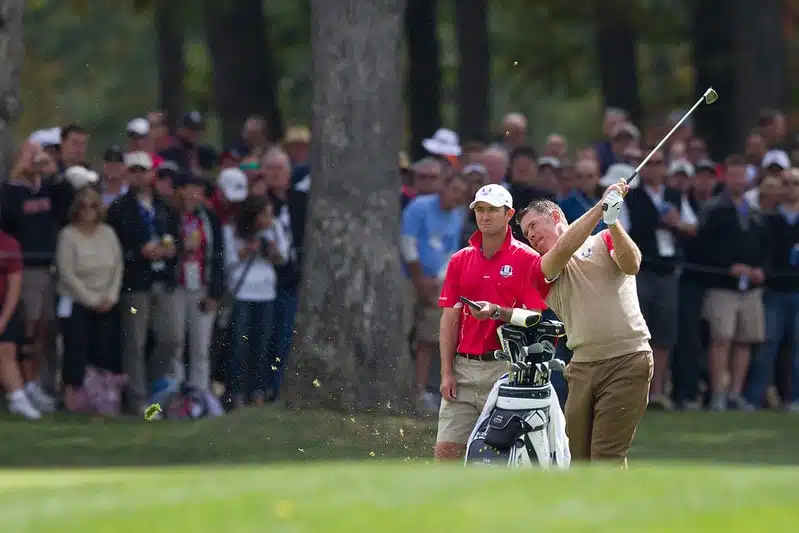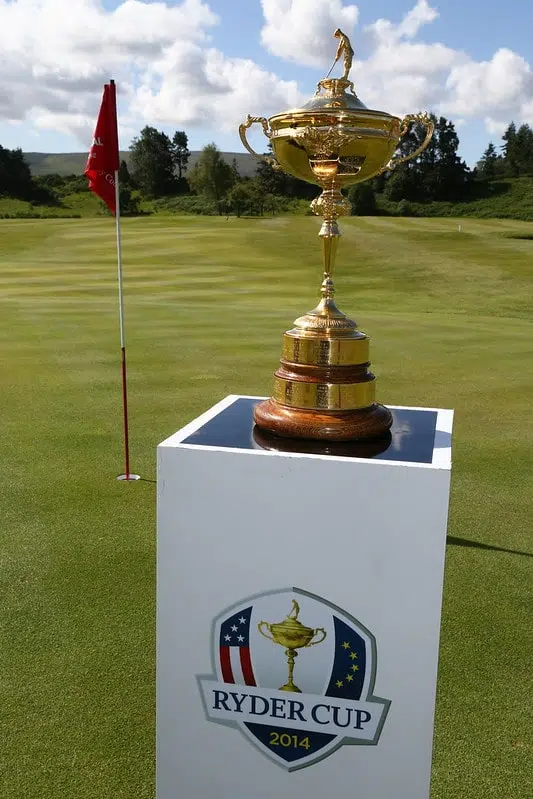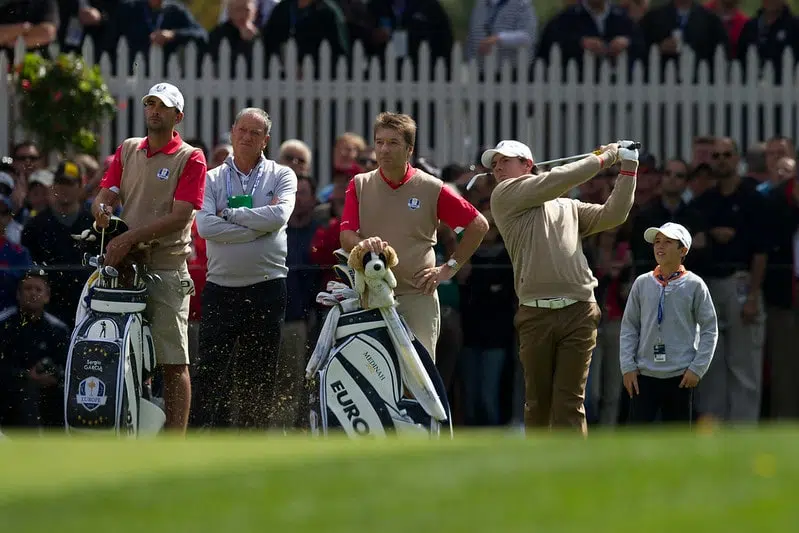The Ryder Cup is a prestigious golf tournament that has captured the hearts of golf fans worldwide since its inception in 1927.
What is the Ryder Cup Format? The Ryder Cup format is unlike other events. It is a biennial competition with 12-player teams from the USA and Europe. It takes place over three days and 28 matches, with the winner being the first team to reach 14.5 points. Teams score 1 point for a win, 0.5 for a draw, and 0 for a loss.
Since the Ryder Cup is so different from the PGA, there are more details to learn about scoring and the selection process.
This comprehensive guide will give you an in-depth understanding of the Ryder Cup format, scoring system, team selection process, history, betting, and more. In this article, we will cover all the key points.
Ryder Cup Format: Overview

The Ryder Cup is a unique competition in golf, as it features a team format rather than the individual stroke-play format commonly seen in other major tournaments. But how does the Ryder Cup work? Here’s a brief overview of the format:
- Day 1: Four foursome matches and four fourball matches
- Day 2: Four foursome matches and four fourball matches
- Day 3: Twelve singles matches
Day 1: Four Foursome Matches and Four Fourball Matches
Foursomes
In this format, two players from each team form a pair and play with only one golf ball, taking alternate shots. Each player in the pair takes turns teeing off, and the team with the lowest score on each hole wins the hole. The team that wins the most holes over the 18-hole match secures a point for their side.
Fourball
In fourball matches, two players from each team also form a pair, but each player plays with their own golf ball. The best individual score from each pair is compared against the opposing team’s best score, with the lowest score winning the hole. The team that wins the most holes throughout the match earns a point for their side.
Day 2: Four Foursome Matches and Four Fourball Matches
The format on day 2 is the same as day 1, with four foursomes matches in the morning and four fourball matches in the afternoon. The players may be different from the previous day, as team captains can change their pairings and line-up to strategize and capitalize on the strengths of their players.
Day 3: Twelve Singles Matches
On the final day of the Ryder Cup, all 12 players compete in singles matches, with one player facing off in a head-to-head match.
The player with the lowest score on each hole wins the hole, and the player who wins the most holes during the match secures a point for their team.
The singles matches provide an exciting finish to the competition, as all players can contribute points to their team’s final Ryder Cup score.
Ryder Cup Previous Winners
| Year | Winning Team | Losing Team | Venue |
| 1927 | USA | GB | Worcester Country Club, USA |
| 1929 | GB | USA | Moortown Golf Club, England |
| 1931 | USA | GB | Scioto Country Club, USA |
| 1933 | GB | USA | Southport and Ainsdale, England |
| 1935 | USA | GB | Ridgewood Country Club, USA |
| 1937 | USA | GB | Southport and Ainsdale, England |
| 1947 | USA | GB | Portland Golf Club, USA |
| 1949 | USA | GB | Ganton Golf Club, England |
| 1951 | USA | GB | Pinehurst Resort, USA |
| 1953 | USA | GB | Wentworth Club, England |
| 1955 | USA | GB | Thunderbird Country Club, USA |
| 1957 | GB | USA | Lindrick Golf Club, England |
| 1959 | USA | GB | Eldorado Golf Club, USA |
| 1961 | USA | GB | Royal Lytham & St Annes, England |
| 1963 | USA | GB | Atlanta Athletic Club, USA |
| 1965 | USA | GB | Royal Birkdale Golf Club, England |
| 1967 | USA | GB | Champions Golf Club, USA |
| 1969 | Tied | Tied | Royal Birkdale Golf Club, England |
| 1971 | USA | GB | Old Warson Country Club, USA |
| 1973 | USA | GB | Muirfield, Scotland |
| 1975 | USA | GB & IRE | Laurel Valley Golf Club, USA |
| 1977 | USA | GB & IRE | Royal Lytham & St Annes, England |
| 1979 | USA | Europe | The Greenbrier, USA |
| 1981 | USA | Europe | Walton Heath Golf Club, England |
| 1983 | USA | Europe | PGA National Golf Club, USA |
| 1985 | Europe | USA | The Belfry, England |
| 1987 | Europe | USA | Muirfield Village, USA |
| 1989 | Tied | Tied | The Belfry, England |
| 1991 | USA | Europe | Kiawah Island Golf Resort, USA |
| 1993 | USA | Europe | The Belfry, England |
| 1995 | Europe | USA | Oak Hill Country Club, USA |
| 1997 | Europe | USA | Valderrama Golf Club, Spain |
| 1999 | USA | Europe | The Country Club, USA |
| 2002 | Europe | USA | The Belfry, England |
| 2004 | Europe | USA | Oakland Hills Country Club, USA |
| 2006 | Europe | USA | The K Club, Ireland |
| 2008 | USA | Europe | Valhalla Golf Club, USA |
| 2010 | Europe | USA | Celtic Manor Resort, Wales |
| 2012 | Europe | USA | Medinah Country Club, USA |
| 2014 | Europe | USA | Gleneagles Hotel, Scotland |
| 2016 | USA | Europe | Hazeltine National Golf Club, USA |
| 2018 | Europe | USA | Le Golf National, France |
| 2021 | USA | Europe | Whistling Straits, USA |
| 2023 | TBD | TBD | Marco Simone, Italy |
Ryder Cup Roster for 2023
Qualification is still in progress, but we know some things. Luke Donald will captain Team Europe, while Zach Johnson will lead Team USA.
Players are likely to change, but Scottie Scheffler would seem to be a shoo-in, given his large points total. From the European perspective, Jon Rahm and Rory McIlroy are leading the way in terms of points on tour.
How Ryder Cup Scoring Works

So, how does the Ryder Cup scoring system work? In the Ryder Cup, each match is worth 1 point, and the team with the most points at the end of the event is the eventual winner. The Ryder Cup scoring method is as follows:
Win: 1 point
Tie: 0.5 points (for both teams)
Loss: 0 points
Win the cup: 14.5 points
To some people, the Ryder Cup point scoring system is a little difficult to follow. Perhaps it’s because of the decimal points teams receive from tying. However, in reality, the scoring is easy to understand, especially when you become used to it. A total of 12 teams are vying for 14.5 points, and they get 0.5 points for a draw and 1 point for a win. It’s really that simple.
If the competition ends in a 14-14 tie, the defending champion retains the trophy.
How Concessions Affect Match-Play
One factor that makes match-play different from typical stroke-play is concessions. In the Ryder Cup, concessions play an essential role in the spirit of sportsmanship and fair competition.
A concession occurs when a player acknowledges that their opponent has won a hole, typically when they have an easy putt remaining. By conceding, the player demonstrates respect and confidence in their opponent’s ability to make the short putt. This act of sportsmanship is a unique aspect of match-play events like the Ryder Cup, fostering camaraderie and goodwill between the two teams.
Concessions can also impact the pace of play, as they allow players to move on to the next hole without completing the current hole. While concessions are a symbol of sportsmanship, they can sometimes be a strategic decision, as a player may choose to concede a hole to maintain momentum or save energy for upcoming challenges.
Ryder Cup Match Formats

As we mentioned above, the rules of the Ryder Cup are different from most golf tournaments. It features three distinct match formats played over the three days of the competition. Days 1 and 2 are the same, consisting of foursome matches in the morning and fourball matches in the afternoon. Day 3, on the other hand, is solely singles play.
Let’s analyze the impact of these formats on the outcomes of the matches.
Foursomes
In foursomes, each two-player team plays with one ball, taking alternate shots. The players must also alternate on tee shots.
This format requires a high level of teamwork and understanding between partners since they need to plan and execute shots together.
Foursomes can impact the outcome of the Ryder Cup by highlighting the importance of pairing players with complementary skills and strong chemistry. A successful partnership in foursomes can set the tone for the rest of the competition and potentially swing momentum in favor of one team.
Fourballs
In fourballs, each player on the two-player team plays their ball, and the best score among the two partners counts for the team. This format is also known as best ball.
The fourball format allows for more aggressive play since each team member can take risks, knowing that their partner can potentially make up for any mistakes. Fourball matches can lead to dramatic comebacks and changes in momentum, as a single fantastic shot can alter the outcome of the match.
Captains must carefully choose pairings that maximize each player’s strengths, ensuring that their team can take advantage of scoring opportunities. We explain fourballs in more detail in our article.
Singles
On the final day of the Ryder Cup, all 12 players from each team face off in head-to-head singles matches. These can significantly impact the outcome of the Ryder Cup, as they offer the most points available in a single day.
Team captains must strategize their line-up based on individual player form and potential matchups against opponents. There is no room for error in singles, and the pressure on each player is immense.
The singles matches often decide which teams get higher Ryder Cup scores, and players’ performances in these high-stakes battles can create lasting memories and turn the tide of the competition.
How Ryder Cup Teams Are Selected

The Ryder Cup teams are chosen through a combination of automatic qualification based on performance and captain’s picks. The selection process and criteria differ for the European and American teams.
European Team:
- The top four players on the European Points List
- The top five players on the World Points List not already qualified
- Three captain’s picks
American Team:
- The top six players on the Ryder Cup Points List
- Six captain’s picks
Team captains are crucial in selecting and managing their teams, including pairings and match order. They have the power to influence the outcome of the tournament by making strategic decisions that can maximize their players’ strengths and exploit the opposing team’s weaknesses.
Ryder Cup’s History and Tradition
The Ryder Cup’s rich history dates back to 1927 when the inaugural event was held at Worcester Country Club in Massachusetts. Originally, the competition was between the United States and Great Britain. In 1979, the British team expanded to include players from continental Europe, creating the modern European team we know today.
Some of the most famous moments in Ryder Cup history include the “Miracle at Medinah” in 2012 when Europe staged a remarkable comeback to win the trophy, and the “Battle of Brookline” in 1999 when the United States rallied for an improbable victory.
These moments showcase the passion and drama that the Ryder Cup embodies. The top players from the USA and Europe take a break from solo play to come together as a team. It is the ultimate symbol of international golf competition.
Ryder Cup’s Course and Venue

The Ryder Cup alternates between venues in the United States and Europe, with each host country and course designer playing a crucial role in selecting and preparing the course for the event.
Ryder Cup courses are known for their challenging layouts, pristine conditions, and unique features that test the skills of the world’s best golfers.
Some famous Ryder Cup venues include Hazeltine National Golf Club (USA), Gleneagles (Scotland), and Le Golf National (France). The selection of the course and venue is a significant aspect of the event. It often reflects the host country’s golfing tradition and culture while presenting a distinct challenge to the players.
In 2023, Marco Simone Golf & Country Club in Rome, Italy, will host the Ryder Cup. Hole 16 is particularly challenging. It features two bunkers and a water hazard to the right. Optimistic players may try to reach the green with a driver, but with the downhill lie, it’s very risky!
Ryder Cup Betting and Odds
Betting on the Ryder Cup is a popular pastime for golf enthusiasts, with various types of bets available, such as outright winner, individual match outcomes, top point-scorer, and more.
Factors such as team form, player performance, and course conditions affect the odds of the Ryder Cup.
When betting on the Ryder Cup, it’s important to consider responsible gambling practices, such as setting limits, researching your bets, and never betting more than you can afford to lose. Remember that the Ryder Cup is unpredictable; anything can happen throughout the competition.
Frequently Asked Questions
How Are the Three Different Ryder Cup Formats Scheduled?
Day 1: Four foursome matches and four fourball matches
Day 2: Four foursome matches and four fourball matches
Day 3: Twelve singles matches
What Does a 4-2-1 Score Mean for The Ryder Cup?
A 4-2-1 score indicates that one team has won four matches, the other team has won two matches, and one match has ended in a tie.
How Many Points Are Required to Win the Ryder Cup?
A team needs to accumulate 14.5 points to win the Ryder Cup. If the competition ends in a 14-14 tie, the defending champion retains the trophy.
Final Thoughts
The Ryder Cup is a unique and exciting event that showcases the best of international golf competition. The distinct Ryder Cup rules and scoring, its rich history, and the fierce rivalry between Europe and the United States make it a must-watch event for golf fans.
As you follow the action and immerse yourself in the Ryder Cup format and experience, we hope this comprehensive guide has provided you with valuable insights into the tournament’s format, scoring system, team selection, and traditions. Enjoy the matches and appreciate the spirit of camaraderie and sportsmanship that the Ryder Cup represents.
Sam has been playing golf for over 20 years and founded Impact Golfer. As a teenager, he discovered his love for the game using his grandad’s clubs, including a wooden driver. As a golf obsessive, Sam plays whenever possible, regularly competing in matchplay with his friends and in tournaments at his local club. He's fortunate to have a close friend who is a club pro– he has tested almost every type of equipment on the market (no freebies yet).
Sam has a handicap index of 13 and likes playing at the Metro Golf Centre near his home in London. He putts with a Taylormade Spider because Rory uses it but regrets selling an old Scotty Cameron putter on eBay.
- Best score: 94
- Favorite club: TaylorMade Stealth Driver
- Favorite putter: Bought a TaylorMade Spider because Rory uses it, but spend most of my time on greens yearning for the Scotty Cameron I sold on eBay.
- Favorite food at the turn: Baguette. Sausages. Bacon. HP Sauce.







